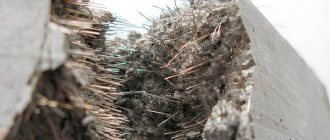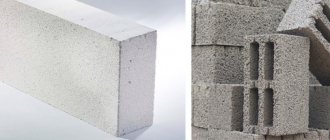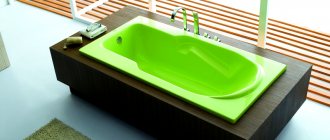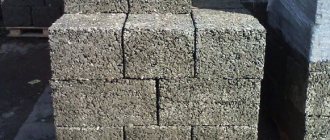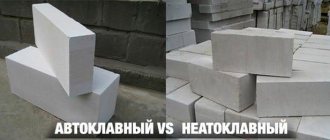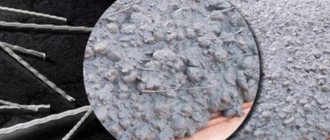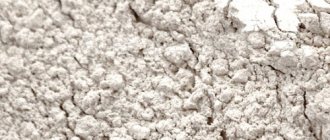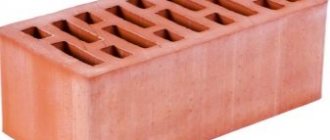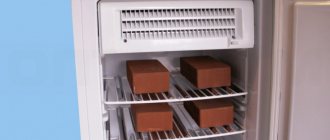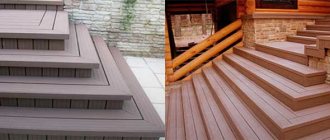Fiberglass concrete - what is it?
You need to know that glass fiber reinforced concrete is a composite material based on cement mortar. Instead of the usual steel reinforcement, it uses fiberglass fiber.
The production of glass fiber reinforced concrete requires cement, sand, fiberglass and water. Sand is not used to create the effect of cutting wood.
Additional Information! Fiber-reinforced concrete panels for the facade can be made to order in the color scheme specified by the client.
There are several technologies for manufacturing glass fiber reinforced concrete:
- Pneumatic spray technology. A special gun is used. He simultaneously applies fiberglass and a cement-sand mixture to the mold. At the exit they are mixed. Equipment with this technology is expensive. But this method is suitable for large products.
- Pneumatic spray of premix. This new technology is used for small and medium-sized decorative elements. The plaster coating is also applied. This method is similar to the first, only factory-cut fiberglass is added to the gun. Then the mixture is applied to the mold by spraying.
- Pre-mixing. This technology can be used without professional equipment. All ingredients are mixed manually or using a concrete mixer. Then they are quickly molded, since fiber-reinforced concrete dries quickly.
Molds for fiber-reinforced concrete are made from different materials:
- Polyurethane. This is the most popular material. It is similar to silicone molds that are used in cooking. It bends just as easily without being damaged. Builders recommend lubricating the mold before starting pouring.
- Fiberglass. With such durable formwork you can reproduce any texture.
- Steel. Used in the manufacture of replicated parts.
- Tree. These forms are the most affordable, but short-lived.
Composition and materials
The composition of glass fiber reinforced concrete is quite simple - gray or white Portland cement M 500-700, sifted fine-caliber quartz sand, roving (alkali-resistant fiberglass), in some cases aluminous cement is used. To improve the characteristics - aesthetic, formative, technological - additives are added to the composition.
The most important point in the process of making your own glass concrete is the choice of binder. The aluminous cement base is characterized by intensive crystallization of formations; the decrease in strength occurs more slowly than in compositions made from Portland cement. In cooperation with water, Portland cement prevents the destruction of metal elements, but has a detrimental effect on glass fiber.
The main component of the liquid phase of Portland cement before hardening - calcium hydroxide - leads to glass corrosion, which destroys the silicon-oxygen structure. Based on this, when making your own glass fiber concrete based on Portland cement, it is advisable to use alkali-resistant fiber - otherwise, instead of reinforced material, you will get a block impregnated with liquid glass.
Concrete made with alumina cement is more dense, resistant to adverse environments, and waterproof, but the cost of this base for concrete is significantly higher and it is more difficult to purchase.
On the other hand, the high price of alumina is absolutely justified. Among their main advantages in use are the following:
rapid hardening; increased strength during the drying process; insignificant influence of chemicals on glass fiber; rapid production of the material, as a result - reduction of construction time.
The only drawback can be considered the possibility of changing the strength characteristics. The use of alumina in construction requires strict adherence to process recommendations - a minimal error will lead to the eventual loss of most of the properties of the finished glass fiber reinforced concrete.
Fiberglass makes up 3 – 5% of the total mass of concrete.
For the manufacture of materials for interior work and finishing, gypsum-based plaster, or gypsum in its pure form, is used. The hardening medium poses virtually no threat of destruction of the reinforcing elements. There is a risk of corrosion of steel parts; fiber is not subject to destruction. Gypsum reinforced with fiber is more durable, fire-resistant and has low thermal conductivity.
Currently reading: Silicate concretes
Glass fiber is selected based on the chemical composition and strength of the material - a wide selection of types of glass allows you to choose the right type, focusing on your selection criteria. The following fibers are predominantly used in the production of glass fiber reinforced concrete:
silicate; quartz; sodium calcium-silicate; aluminoborosilicate; zirconium silicate (alkali-resistant glass fiber). Return to contents
Characteristic. Properties
Glass fiber reinforced concrete has the following characteristics:
- Density 1800 - 2200 kg/m3;
- Compressive strength 48.9 - 83.8 MPa;
- Thermal conductivity 3.6 - 6.8;
- Water permeability W6 - W19;
- Frost resistance F160 – F290;
- Water absorption by weight 12 - 16%;
- Fire resistance is higher than the fire resistance of concrete;
Manufacturers offer a huge selection of glass fiber reinforced concrete products. The building material can imitate natural materials: stone, wood or building materials: brick.
Main characteristics of SFB
| Characteristic | Meaning |
| Density (dry) | 1700-2250 kg/m3 |
| Charpy impact strength | 1.1-2.5 kg•mm/mm2 |
| Compressive Strength | 490-840 kg/cm2 |
| Bending tensile strength | 210-320 kg/cm2 |
| Elastic modulus | (1.0-2.5)•104 MPa |
| Axial tensile strength: | — conditional elastic limit 28-70 kg/cm2 — tensile strength 70-112 kg/cm2 |
| Elongation at failure | (600-1200)•10-5 or 0.6-1.2% |
| Shear resistance: | - between layers 35-54 kg/cm2 - across layers 70-102 kg/cm2 |
| Thermal expansion coefficient | (8-12)•10-6 °С-1 |
| Thermal conductivity | 0.52-0.75 W/cm2•°С |
| Water resistance according to GOST 12730 | W6-W20 |
| Filtration coefficient | 10-8-10-10 cm/s |
| Frost resistance according to GOST 100600 | F150-F300 |
| Fire resistance | Higher fire resistance than concrete |
| Combustibility | Fireproof material |
| Sound absorption | (thickness 15 mm) 125 Hz / 27 dB 250 Hz / 30 dB 500 Hz / 35 dB 1000 Hz / 39 dB 2000 Hz / 40 dB |
The key features of glass fiber reinforced concrete are the authentic repetition of the textures of sandstone, slate, wood, architectural expressiveness and plasticity. In addition, among cement-containing and other building materials, it is the most environmentally friendly.
Facade cladding with glass fiber reinforced concrete: pros and cons
The advantages of this type of concrete include:
- high compressive and tensile strength;
- high impact strength;
- excellent anti-vandal characteristics;
- light weight of glass fiber concrete panels;
- resistance to temperature changes;
- plasticity of the material (creation of unique and non-standard objects);
- efficiency;
- non-flammability of the material;
- service life from 20 years;
- good adhesion to ordinary concrete;
- high level of sound insulation;
- fiber-reinforced concrete does not corrode.
The disadvantages of glass fiber reinforced concrete include:
- instability of fiber fiber in an alkaline environment;
- gypsum boards wear out quickly if used for exterior decoration.
Composition of building materials
Glass fiber reinforced concrete (GFRC) is an environmentally friendly and absolutely harmless building material for humans. It consists of concrete and reinforcing materials, including polymer alkali-resistant fiber, as well as auxiliary ingredients such as:
- water;
- sand;
- Portland cement.
Thanks to the combination of such substances in its composition, glass fiber reinforced concrete has the following advantages:
- does not corrode;
- lightweight and compact;
- has high strength characteristics;
- relatively inexpensive;
- allows you to create original surfaces.
The special composition of the material provides a whole range of its positive properties.
Glass fiber reinforced concrete also has disadvantages. Among them, low alkali resistance is distinguished, which requires the additional use of alkali-resistant glass fiber. In addition, the “rigidity” of the building material is considered a disadvantage, due to which glass fiber reinforced concrete must be laid as quickly as possible, otherwise it will harden.
Areas of application in construction
Glass fiber reinforced concrete panels are used to cover the facade and decorate it. It is also used to make soundproofing blocks, small architectural forms, and roofing materials.
It is worth mentioning separately about the façade decor made of glass fiber reinforced concrete. Fiber-reinforced concrete allows you to make complex-shaped parts of buildings and structures. It is used in the reconstruction of historical buildings and in the interior decoration of premises. Country houses or cottages are decorated with the same complex decor made of glass fiber reinforced concrete. These can be columns, pilasters, relief cornices and platbands, medallions, bas-reliefs, arches, keystones and other details. The result is a unique and thin stucco molding.
Sometimes floors are made from glass fiber reinforced concrete. This helps reduce pressure on supporting structures and foundations, which is important when constructing multi-story and high-rise buildings.
Properties of glass fiber reinforced concrete
The unique characteristics of the material make it in demand when carrying out various construction and finishing works, allowing not only to obtain high-quality and durable results, but also to implement modern architectural ideas of any complexity. The material has the following properties:
- environmental friendliness and safety;
- waterproof and fire resistant (K-0);
- the possibility of constructing and finishing buildings in earthquake-prone regions;
- good adhesion to ordinary concrete;
- resistance to temperature changes and high humidity;
- resistance to mechanical and chemical influences, corrosion;
- high level of sound insulation;
- plasticity, the ability to implement bold architectural solutions.
The use of glass fiber reinforced concrete in the decoration of facades allows one to achieve unique visual effects: the material is highly aesthetic, and with proper processing, translucent structures can be achieved. The material can be colored either by applying a colorant to the surface of the finished structure, or by injecting the colorant directly into the concrete mixture. This allows for unusual and varied visual effects to be produced.
Installation of panels, basic methods
The facade made of glass fiber reinforced concrete is mounted in several ways:
- Visible fastening of panels. Rivets or screws are used. Installation using rivets is carried out on the guides that form the system. Mounting brackets and vertical profiles will be required. The slabs are installed on fixed and floating points. When temperature changes, the material expands. This method saves the material from destruction. When the panels are secured with bolts, they are drilled through. Through the holes, the slabs are fixed to the guide profiles.
- Hidden installation. This method is used most often due to its aesthetic appeal. They are fixed with anchor plates. This allows you to imitate wooden panels and masonry. The parts are attached with self-tapping screws to the back side of the slab, and then “hung” on the guides.
Note! Glass fiber reinforced concrete panels are installed in compliance with the technological seam. Its size is 7-12 mm. In the final processing, the seams should be closed with additional profiles.
Corners are a specific part of the facade, so fastening here is a separate fastening method. The corner joint is made with an overlap or by sawing the panel. This is done at an angle of 45 degrees. The back part of the corner joint is reinforced with a metal corner.
There is another way. The square-shaped profile is mounted in the wall at the joint. Then the panels are attached to it at an angle of 90 degrees.
For what purposes is glass fiber reinforced concrete used?
Compared to conventional concrete, glass fiber reinforced concrete has the following advantages:
- ease,
- tensile, compressive and bending strength,
- tensile strength is 5 times higher,
- impact strength is 15 times higher,
- frost resistance is increased up to 300 cycles.
The material is dense, fast-hardening and mechanically strong even in a relatively small layer (plates less than 1 cm thick can be made from it). This allows the molding of thin-walled and very strong products with a smooth surface.
The plasticity of a material based on a fine-grained concrete matrix (sometimes containing no sand at all) allows one to achieve textures with any given properties and parameters, imitate different materials, and obtain complex shapes. Facade decor made from glass fiber reinforced concrete is an excellent alternative to gypsum and concrete stucco and plasters.
Slabs of different thicknesses are used as curtain and ventilated facades, wall and cladding materials, replace tiles, and are also used as a more promising floor material than conventional reinforced concrete.
Due to its lightness, glass fiber reinforced concrete significantly reduces the load on load-bearing walls and foundations, making it possible to increase the number of floors in buildings.
Characteristics of glass fiber reinforced concrete
Fiber-reinforced concrete is a construction and finishing material with unique properties, which in its characteristics and strength indicators is superior to traditional concrete.
Among the characteristics of glass fiber reinforced concrete are:
- Strength. Architectural decor, sculptures and monuments, cladding panels, permanent formwork and other products made from glass fiber reinforced concrete have anti-vandal properties and the ability to withstand significant mechanical loads.
- Plastic. The finished composition used for spraying and casting products in molds has good ductility and casting properties. These characteristics make it possible to produce products with a smooth or textured surface, simulating the texture of natural and artificial materials.
- Manufacturability. Fiberglass concrete lends itself well to processing - grinding, polishing, painting.
- Weather resistance. Sculptures and façade decor made of fiber-reinforced concrete are resistant to UV radiation and are not afraid of rain, wet snow, or temperature changes.
- Ease. Fiber-reinforced concrete, reinforced with glass fiber, is lightweight compared to traditional concrete. Durable and lightweight cladding panels and facade elements do not load load-bearing walls and foundations, which allows the use of architectural decor made of fiber-reinforced concrete to decorate the facades of old buildings and objects of artistic and historical value.
- Durability. The service life of glass fiber concrete products is 50 years. The durability of fiber-reinforced concrete allows you to increase the maintenance-free service life of facade finishing.
